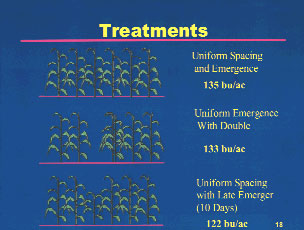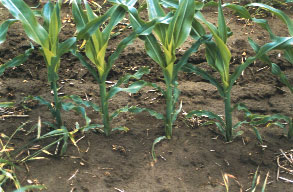
Corn Planter Pit Stop
Uniform
Emergence: Start Here!
The first and best dollar spent on your corn planter is to ensure uniform emergence.
Your planter simply must be able to cut a clean V into moisture, lay the seed
in the bottom of that trench and cover and firm the soil around it. A new double
disc and bearing at approximately $35 dollars is well worth the cost if your current
disc assemblies are worn out. Also be sure the pinch point on the double disc
openers is tight. If your run a business card between the opener discs, you should
not be able to remove it as it passes through the 4 o’clock to 6 o’clock
positions on the openers. Adjustment of the shims may improve this if the discs
themselves are still in reasonable shape.
 There
has been much interest in devices to firm the seed into the seed furrow. In good
planting conditions with a well-maintained planter, the improvement from these
is likely to be very marginal. However, when going gets a little tougher and soil
moisture less available, the improvement in seed contact with moist soil at the
bottom of the furrow would be a real benefit.
There
has been much interest in devices to firm the seed into the seed furrow. In good
planting conditions with a well-maintained planter, the improvement from these
is likely to be very marginal. However, when going gets a little tougher and soil
moisture less available, the improvement in seed contact with moist soil at the
bottom of the furrow would be a real benefit.
For some growers, management of the planter closing wheels is both art and science;
they adjust wheels frequently depending on soil conditions. Others have never
been touched since the day the equipment was purchased. Take a moment to ensure
wheels are running square over the row and move freely with a reasonable amount
of pressure.
I have been intrigued for some time by the debate over the importance of uniformity
of emergence versus uniformity of spacing. Researchers at the University of Guelph,
Dr. Bill Deen and Weidong Liu, have conducted some careful examinations of these
factors over the past two years. Figure 1 illustrates three of the hand-planted
comparisons they conducted: 1) uniformity in both spacing and emergence, 2) uniform
emergence but creating a double, and 3) uniform spacing but with a late-emerging
plant. The results indicate that the late-emerging plant dragged yields down considerably
more than the poorly spaced plant.
Moral of the story: do not spend money ensuring that spacing and population are
exact if you have not first ensured that the planter will place the seed in the
ground in such a way as to provide very uniform emergence.
Getting
the Population Right
Getting the corn plant density correct requires an appreciation of the fact
that high density contributes both to producing higher yields and to raising
the total stress that the corn plant experiences. Stress can reduce yields and/or
lower stalk strength. Getting the population right means getting it right for
the hybrid you are growing and getting it right for the yield potential of the
field. Much of the potential yield gain from modern hybrids comes from the development
of hybrids that excel under higher densities. So while over the past decade
we may have set 28-30,000 plants per acre as all you would ever need to maximize
corn yield, that won’t likely be true in the future. However, some hybrids
on the market now show no advantage beyond 27,000 ppa. Work with your seed representative
to fine-tune planting density for the hybrids you are growing.
|
Figure
2. While scouting your fields, be aware that a plant that is 2 leaves
behind its neighbours will often cause a significant yield reduction.
|
 |
If you are going
to have any confidence in your ability to adjust populations for different hybrids
or different fields, you will need to do some additional work with your planter.
Checking the planter in the yard for seed drop at one setting is a good start,
but better by far is to run checks on settings that will deliver 28,000 and
35,000 seeds per acre as well. Remember to check that the inflation
pressure is correct in all planter tires before doing any seed counts, and that
17.5 feet of row length on 30-inch rows represents 1/1000th of an acre.
Moral of this story: there are certain fields (i.e., drought prone) and certain
hybrids (i.e., lower stalk strength) where lowering the population will save
you money and cost you nothing. There are certain fields (high water-supplying
capacity) and certain hybrids where you are sacrificing yield potential if you
are not boosting your seed drop beyond 32,000. A well-tuned planter will give
you the ability to pursue both scenarios successfully.
Fertilizer
Dry planting seasons generally contribute to more fertilizer injury to corn
than we would care to see. It is worthwhile checking to ensure that the fertilizer
openers on planters have not migrated closer to the row than expected. Safe
rates as outlined in OMAFRA publication 296 indicate that total nitrogen and
potash should not exceed 90 kg/ha (60 kg/ha if the N source is urea). These
recommendations are based on a fertilizer band placed 5 cm beside and 5 cm below
the seed. In cases where the fertilizer band cannot be placed 5 cm below the
depth of the seed and/or the soil type lends itself to dry seedbed conditions,
care should be taken to reduce the rate of total N and K applied, or the fertilizer
opener should be moved further to the side. Note however that in no-till situations
and in cropping systems where nitrogen is side-dressed, adequate nitrogen fertility
at planting can be very important to early growth and yield. Under these situations,
the suggestion is to apply 30 kg N/ha during the planter operation.